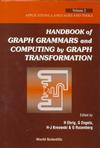图文法及图像转换计算手册,卷二
出版时间:1999-10 出版社:Penguin 作者:Ehrig, H.; Engels, G.; Kreowski, H. J. 页数:698
内容概要
Graph grammars originated in the late 60s, motivated by considerations about pattern recognition and compiler construction. Since then, the list of areas which have interacted with the development of graph grammars has grown quite impressively. Besides the aforementioned areas, it includes software specification and development, VLSI layout schemes, database design, modeling of concurrent systems, massively parallel computer architectures, logic programming, computer animation, developmental biology, music composition, visual languages, and many others. The area of graph grammars and graph transformations generalizes formal language theory based on strings and the theory of term rewriting based on trees. As a matter of fact, within the area of graph grammars, graph transformation is considered as a fundamental computation paradigm where computation includes specification, programming, and implementation. Over the last three decades, graph grammars have developed at a steady pace into a theoretically attractive and important-for-applications research field. Volume 2 of the indispensable Handbook of Graph Grammars and Computing by Graph Transformations considers applications to functional languages, visual and object-oriented languages, software engineering, mechanical engineering, chemical process engineering, and images. It also presents implemented specification languages and tools, and structuring and modularization concepts for specification languages. The contributions have been written in a tutorial/survey style by the top experts in the corresponding areas. This volume is accompanied by a CD-Rom containing implementations of specification environments based on graph transformation systems, and tools whose implementation is based on the use of graph transformation systems.
书籍目录
Ⅰ Term Rewriting and Functional Languages 1 Term Graph Rewriting (D. Plump) 1.1 Introduction 1.2 Abstract Reduction Systems 1.3 Term Graphs 1.3.1 From Hypergraphs to Term Graphs 1.3.2 Collapsing, Copying and Bisimilarity 1.3.3 Bibliographic Notes 1.4 Term Graph Rewriting 1.4.1 Term Rewriting 1.4.2 Term Graph Rewriting 1.4.3 Incorporating Collapsing and Copying 1.4.4 Bibliographic Notes 1.5 Completeness 1.5.1 Simulating Arbitrary Term Rewrite Derivations 1.5.2 Graph-Reducihility 1.5.3 Bibliographic Notes 1.6 Termination 1.6.1 The Relation to Term Rewriting 1.6.2 Combined Systems 1.6.3 A Recursive Path Order on Term Graphs 1.7 Confluence 1.7.1 The Relation to Term Rewriting 1.7.2 Decidability and Combined Systems 1.7.3 Plain Term Graph Rewriting and Confluence Modulo Bisimilarity 1.8 Term Graph Narrowing 1.8.1 Term Graph Narrowing 1.8.2 Minimally and Maximally Collapsing Narrowing 1.8.3 Bibliographic Notes 1.9 Further Topics References 2 Graph Rewriting Aspects of ~nctional Programming (E. Barendsen, S. Smetsers) 2.1 Introduction 2.2 Term Graphs 2.3 Graph Rewriting 2.3.1 Graph Rewriting in Practice 2.4 Copying 2.4.1 Copying in Practice 2.5 Operational Semantics 2.5.1 Reduction Strategies 2.5.2 Graph Syntax 2.5.3 Operational Semantics 2.5.4 Translating Rewrite Systems 2.6 Typing Systems 2.6.1 Standard Typing 2.6.2 Strictness Analysis 2.6.3 Recursive Data Types 2.6.4 Strictness Analysis in Practice ReferencesⅡ Visual and Object-Oriented Languages 3 Application of Graph Transformation to Visual Languages (R. Bardoh], M. Minas, A. Schiirr, G. Taentzer) 3.1 Introduction 3.2 Visual Languages and Environments 3.3 Defining the Syntax of Visual Languages 3.3.1 Concrete and Abstract Syntax of Visual Languages 3.3.2 Graph Grammars 3.3.3 Hypergraph Representation of Visual Sentences 3.3.4 Graph Structure Representation of Visual Sentences 3.4 Generating Visual Language Editors 3.4.1 Visual Editing Modes 3.4.2 GENGED 3.4.3 DIAGEN 3.5 Generating Visual Language Parsers 3.5.1 The Visual Language Parsing Problem 3.5.2 Parsing for Context-Free Hypergraph Grammars 3.5.3 Parsing for Context-Free Hypergraph Grammars with Embeddings 3.5.4 Parsing for Layered Graph Grammars 3.6 Visual Graph Transformation Languages ……Ⅲ Applications to Software EngineeringⅣ Applications to Engineering DisciplinesⅤ Applications to PicturesⅥ Implemented Specification Languages and ToolsIndex
图书封面
评论、评分、阅读与下载
用户评论 (总计0条)
推荐图书
- 汉克历险记
- 2年级小学音乐学生用书Textbook P2
- 学校里面的新小孩The New Kid at School
- 迅猛的恐龙 NIPPY THE SPEEDY DINOSAUR
- 国际文化创意产业园区发展研究报告
- 中国玉文化玉学论丛四编(上下)
- 城市遥感考古
- 地球科学通论
- 四季家庭套餐
- (翩翩起舞的安吉利娜)Angelina Ballerina in the Wings
- 2年级小学英语学生用书BCourse Book Primary 2B
- 厦门市博物馆藏品集粹
- 人工神经网络理论、设计及应用
- 移动机器人技术及其应用
- 智能控制原理与应用
- 过程控制调节仪表
- 机器学习及其应用2007
- 机器人学
- 马尔可夫点进程及其应用MARKOV POINT PROCESSES AND THEIR APPLICATIONS
- 20世纪的数学逻辑MATHEMATICAL LOGIC IN THE 20TH CENTURY
- 人造黑洞/ARTIFICIAL BLACK HOLES
- 理论物理学数学透视
- 加速器物理及工程学手册HANDBOOK OF ACCELERATOR PHYSICS AND ENGINEERING
- 聚变能原理
- 非齐次矩阵积/NONHOMOGENEOUS MATRIX PRODUCTS
相关图书
- 勒贝格积分与Henstock-Kurzweil积分之间的求积法
- 压力分析的基础与应用FUNDAMENTAL AND APPLIED PRESSURE ANALYSIS
- 有关农作物的杀虫剂应用APPLICATION OF PESTICIDES TO CROPS
- 正电子与电子偶素化学之原理与应用PRINCIPLES AND APPLICATIONS OF POSITRON
- 管理、金融及统计中的C++编程应用
- 动态视觉
- 基础化学热力学BASIC CHEMICAL THERMODYNAMICS
- 集成测试框架
- 刑事诉讼与廉政建设
- 我国刑事证据规则体系构建研究
- 法官语言
- 儿童毛衣图案大全
- 钩针常见款式个性化设计
- 设计表现技法
- 欧美顶级品牌最新卖场设计
- 土地问题的制度分析-以政府行为为研究视角
- 5年级小学英语学生用书EM1/2BCourse Book Primary 5B EM1/2
- 4年级小学英语学生用书BCourse Book Primary 4B
- 5年级小学英语活动用书EM3BActivity Book Primary 5B EM3
- 5年级小学英语活动用书EM3AActivity Book Primary 5A EM3
- 5年级小学英语活动用书EM1/2AActivity Book Primary 5A EM1/2
- 6年级小学英语学生用书
- 草莓脆饼-秘密与惊喜'Strawberry Shortcake
- 2年级小学英语活动用书BActivity Book Primary 2B
- 6年级小学英语活动用书 EM 1/2AActivity Book Primary 6A EM 1/2
